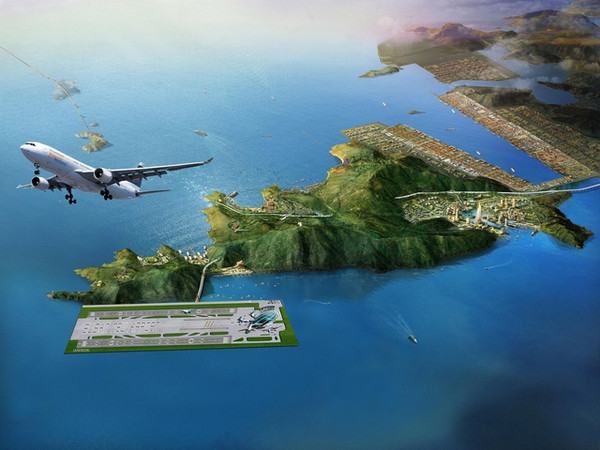For a nation, an airport means more than just a ‘take-off and landing place for airplanes.’ Especially an airline hub, a center of a particular region in the world, plays a major role in developing the national economy. In Korea, Incheon Airport in the metropolitan area has played a role as an airline hub in Northeast Asia. Recently, there has been an active movement to create a second major international Airport in a non-metropoltian area. ‘The Special Bill for the Construction of Gadeokdo New Airport’ passed the plenary session of the National Assembly on February 26th, which confirms the location of the new airport in the Southeast region to Gadeok Island, Busan. The Gadeokdo New Airport project, which had been the desire of southeastern citizens for the past 20 years, was rapidly carried out ahead of the Busan mayor’s by-election in April. For this reason, some criticize that the ruling and opposing parties are pushing ahead too fast simply to win local public sentiment. Controversy also continues over the feasibility of the new airport on Gadeok Island. Let's take a look at what kind of controversy is going on over Gadeokdo New Airport and why this airport is necessary.
Gadeokdo New Airport Project

The history of Gadeokdo new airport project dates back to 1992. The saturation of the old and narrow Gimhae International Airport at that time raised the need for the construction of a new airport, and the contents were first reflected in the Busan urban plan that year. The 2002 Air China Flight 129 crash in Mt. Dotdae, Gimhae accelerated the discussion. This is because the need for a safe new airport to replace Gimhae International Airport, which is dangerous as it is close to the mountain, has grown. The former President Roh Moo-hyun embarked on the project in December 2006 as he ordered the Ministry of Construction and Transportation to review plans for a new airport in the southeast area. Former President Lee Myung-bak also set the construction of the southeast’s new airport as an election promise when he was a presidential candidate in December 2007. In 2009, the government narrowed down the candidates for the new airport to two locations: Miryang, South Gyeongsang Province (Gyeongnam) and Gadeokdo, Busan. However, in March 2011, the government judged that the construction of both candidate sites was inappropriate due to environmental damage and lack of economic feasibility. In the same direction, the Park Geun-hye administration rescinded the new airport project and announced a plan to expand Gimhae Airport. In May 2017, President Moon Jae-in pushed for the construction of a gateway airport in the southeastern region, and in February 2019, he mentioned reconsidering the expansion of Gimhae Airport. The Gimhae New Airport Plan was finally scrapped in November 2020 as the verification committee under the Prime Minister's Office announced that a fundamental review of the Gimhae Airport was necessary. The ruling party finally confirmed the location of the new airport to Gadeokdo and the special law passed the National Assembly only three months after the committee’s announcement.
Controversy Over the Feasibility of Building Gadeokdo New Airport


Economic Feasibility
The Ministry of Land, Infrastructure and Transport (MOLIT), which is the competent authority of the new airport project, announced a special report on the review of Gadeokdo’s new airport and submitted it to the National Assembly. The report pointed out various problems with the new airport in Gadeokdo. First, it predicted that the project cost will reach 28.6 trillion won if two runways are built and all international and military facilities in Gimhae Airport are relocated to Gadeokdo Airport. This is 6.2 times more than the construction cost of Gimhae New Airport, which was 4.6 trillion won, and 4 times the 7.5 trillion won proposed by the Busan city government. The reason why the budget was set high is that the MOLIT regarded integrating Gimhae Airport and building two runways as the most efficient option. Unlike the MOLIT, the Busan city government proposed a plan to maintain Gimhae Airport’s domestic flights while Gadeokdo New Airport operates international flights with one runway. In the report, the MOLIT pointed out that the Busan city government’s plan will increase the inefficiency of aircraft operations and create a risk of collision with two airports in operation. On the other hand, the Busan city government countered that the construction budget would be 7.54 trillion won. It claimed that the MOLIT over-inflated the construction budget by including unrealistic and unnecessary costs. It also pointed out that the MOLIT did not consider Busan's plan to reduce expensive landfill costs by reducing the sea landfill area from 75% to 43%.
Safety
The MOLIT also warned about the stability of the new airport. The report reiterated that "There is a risk in taking off and landing aircraft" and that "there is no precedent for offshore airports that are disadvantageous to the safe operation like the Gadeokdo New Airport." The MOLIT compared Gadeokdo airport with eight foreign airports built by filling the sea, including Kansai Airport in Japan, Changi in Singapore, and Brisbane in Australia. Unlike all eight airports located in inland seas, Gadeokdo is in the open sea. The MOLIT pointed out that the airport in the inland sea is less affected by waves and wind, but Gadeokdo New Airport, which is in the open sea, is feared to be less stable. According to the report, the location and structure of the runway are also vulnerable to safety. The runway will be set up across the sea and land sections because Gadeokdo New Airport will be built by landfill both seas in the part of the island’s middle. As a result, there is a greater risk of ‘differential settlement’, in which the ground falls sharply, and it leads to a risk during take offs and landings. However, Kim Young-chun, the candidate for Busan mayor of the Democratic Party, countered, "The differential settlement phenomenon was equally worrisome for all offshore buried airports around the world, but most of them are operating without any problems except for Kansai Airport in Japan."
Controversy over the Special Bill for Gadeokdo New Airport
Is It a Hasty Legislation?
There were voices of concern that careful discussion and investigation should be conducted as it is a large-scale national project and there are high concerns about the feasibility of the project. However, the special bill passed the National Assembly in a short period, and therefore some criticized that politicians had used a large-scale national project to attract public sentiment in Busan, Ulsan, and Gyeongnam ahead of the by-election in April. “How can the special law, which skipped the various procedures required to build an airport, be justified?”, asked Hwang Yong-sik, a professor of business administration at Sejong University. On the other hand, some refuted the criticism saying it is premature. Former Blue House Chief of Staff Lim Jong-suk welcomed the passage of the special bill on February 27th, saying, “The special bill for Gadeokdo New Airport is rather to normalize the national vision that was sacrificed by political logic in the past.” Democratic Party lawmaker Park Joo-min also said, “The project has been under review for a long time, [and that] it is right to think that we are finally speeding up.”
Exemption of Preliminary Feasibility Study
According to the special bill, the Minister of Economy and Finance can exempt the Preliminary Feasibility Study (PFS), which reviews economic feasibility, etc., if necessary, for the rapid and smooth implementation of the project. If the PFS is exempted, Gadeokdo New Airport project will be evaluated only by the Feasibility Study (FS), the former step of the PFS. However, some experts criticized that there is a lot of uncertainty when conducting just the FS before doing the FPS. “The preliminary feasibility study tends to focus on negative variables, such as when demand is lower than expected [and] commonly draws a much more cautious conclusion than the FS”, said Kim Byung-jong, a professor at Korea Aerospace University. Hur Hee-young, a professor at the same university, also pointed out, “It is questionable whether the PS conducted by the MOLIT will be properly conducted under the political atmosphere that actively promotes Gadeokdo New Airport.” However, some argue that exemption of PFS is not a wrong move. "The PFS often does not meet the purpose of balanced national development because it tends to produce good results in large and bustling areas and bad results in remote and isolated areas,” explained Rep. Park Joo-min. In fact, for the balanced national development, the government has selected some projects that can be conducted without the PFS every year so that local long-cherished projects can be carried out. Cho Hae-jin, a lawmaker of the People Power Party, also said, "It is not right to absolutely trust the PFS as it has served to strengthen the provinces’ underdevelopment.”
Necessity of Gadeokdo New Airport
Balanced Development Through the Establishment of ‘Southeastern Mega City’

The Gadeokdo New Airport project originally began due to ‘stability,’ but the current need for this airport is more than that. The new airport project is deeply related to the Regionally Balanced New Deal, one of the government’s biggest projects. Many experts said that a regional metropolitan area must be created for the Regionally Balanced New Deal to succeed. In other words, balanced development is possible only when regional mega-cities that can compete with the Seoul metropolitan area are created by pan-regional cooperation. A representative example of the government's Regionally Balanced New Deal is ‘Southeastern Mega City’. The Southeastern Mega City envisioned by the government will forge an economic bloc with a total of eight million residents in Busan, Ulsan, and Gyeongnam. Gadeokdo New Airport is the key to establishing Southeast Mega City. Seo Young-kyo, chairman of the National Assembly's Public Administration and Security Committee said, “Southeastern Mega City is a good example of the pan-regional cooperation, and essential infrastructure such as Gadeokdo New Airport must be built quickly to gain momentum.”
Leap into a Global Logistics City Through ‘Tri-Port’
The reason why citizens of Busan, Ulsan, and Gyeongnam have wanted the new airport for a long time is because they dreamed of making a tri-port of land(railways), sea(ports), and air(aviation) to make a global logistics city. The acting mayor of Busan, Lee Byung-jin said, “Gadeokdo New Airport will make the southeast part of Korea a global economic city by completing a tri-port equipped with railways, ports, and aviation.” It is not new that logistics has grown in importance worldwide, but its importance has grown higher, especially as non-face-to-face transactions have become commonplace due to the COVID-19. That's why many people emphasize the establishment of a tri-port, an integrated logistics system. The Governor of South Gyeongsang Province Kim Kyung-soo said on February 25th that “the completion of the new airport in Gadeokdo will pave the way for the smart integrated logistics industry linked to Busan New Port to be promoted in earnest.” Busan Port is the world's sixth-largest commercial shipping port. However, the Busan Port Authority pointed out that the existing land transportation-oriented system of Busan Port has limitations in growing as a global logistics hub. Incheon Airport currently handles most of the domestic air freight. As a result, the logistics costs of companies located in the southeast are very high, and the economic costs of southeastern citizens to and from Incheon Airport also cannot be ignored. "If a new airport on Gadeokdo is built near Busan Port, clearance time from Busan to Incheon can be reduced to less than half of its current level. It is also expected that the proportion of transshipment cargo will increase significantly,” said Yeon Jung-heum, head of logistics research at Busan Port Authority.
The Busan city government designed a roadmap aimed at opening the airport by 2029. The MOLIT, which had previously expressed concern about the construction, also expressed its position that as the special law has been enacted, it will do its best to ensure that the new airport is built smoothly. Many people expect that Gadeokdo New Airport will contribute greatly to the national balanced development by creating a global logistics hub and serving as priming water for the construction of Southeastern Mega City. However, it is also necessary to listen to voices concerned about the construction of the airport. Southeastern citizens, especially Busan citizens, may say their wish has been resolved, but we should look at the project cool-headedly as it is a large-scale national project. The CAH hopes that the new airport project will go smoothly and the Korean economy will take a leap forward.

